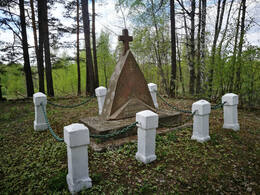Sisters rescued machine guns and wounded soldiers in Baltriškės
The story of sisters who were awarded the Order of the Cross of Vytis for helping the army in the battles against the Bolsheviks.
In the summer of 1919, heavy and tense battles between the Lithuanian army and the Bolsheviks took place in Aukštaitija. On June 6–7, the 1st Infantry Regiment attacked the Bolsheviks on the Antalieptė–Mikučiai–Ikunčiai–Baltriškės line and occupied it. The Bolsheviks, who soon recovered, launched a counterattack and forced the soldiers of the 1st Infantry Regiment to withdraw from their occupied positions. The Bolshevik attack was so sudden and strong that the retreating soldiers left behind 5 wounded and two heavy machine guns, which were extremely important and valued weapons of that time. Sisters Anelė and Kostutė, who lived in a nearby farmstead, pretended to be going to look for animals, secretly ran to Baltriškės, provided assistance to the abandoned and wounded soldiers, bandaged their wounds, and led them “through thickets and bushes” to their relatives in the village of Jakunčiai. The Bolsheviks nearby did not notice them, so the sisters, under the guise of herding livestock, returned to rescue the machine guns, but unable to lift them, they "threw them down the hill" and rushed to notify the soldiers of the 1st Infantry Regiment. The latter, led by Anelė and Kostutė, recovered the machine guns.
This was not the only time the Juozonytė sisters helped the soldiers of the Lithuanian army. On August 23–24, 1919, the 1st Infantry Regiment, together with other units, launched the “Zarasų Operation”. A Bolshevik battery located next to the Juozonytės’ house in Subatiškės was firing at the attacking Lithuanian army. Noticing this, Kostutė cut the telephone cable running through the fields with an axe, which connected the Red Army battery in Subatiškės with the artillery fire tracking point in the Pakunigė fields position. From that moment on, the Bolshevik guns in Subatiškės fell silent.
V. Lesčius, The Lithuanian Army in the Struggle for Independence 1918–1920, Vilnius, 2001.
Related objects
A monument marking the place of death of the first Lithuanian Military School graduate, soldier Jurgis Sidaravičius
In 1919. on the night of August 23 to 24. The 1st Infantry Regiment of the Lithuanian Army launched the Zarasai-Daugavpils offensive operation, with the aim of forcing the Red Army to withdraw from Lithuanian territory. The most important direction of the regiment's attack was towards Zarasai along the Daugavpils-Kaunas highway. Taking advantage of the extremely mountainous terrain and lakes, the Bolsheviks were well entrenched in the Bružai position and successfully stopped the attackers. 15 Lithuanian soldiers were killed during the attack on the Bolshevik defensive positions, including the first student of the Military School to die in the battles for Lithuanian independence, private Jurgis Sidaravičius (1900–1919).
During the interwar period, the soldiers of the 1st Infantry Regiment and the students of the Military School took care of the memory of J. Sidaravičius. At the place of his death, the Baltriškės riflemen in August 1939 erected a beautiful granite monument with the text: "1919.VIII.24. ATA. At the rising of the sun of freedom, the 1st pp. caružas Jurgis Sidaravičius died honorably." The monument is located in a very remote place on a high hill, so it did not come into the way of the Soviet authorities during the Soviet years and was not demolished.





